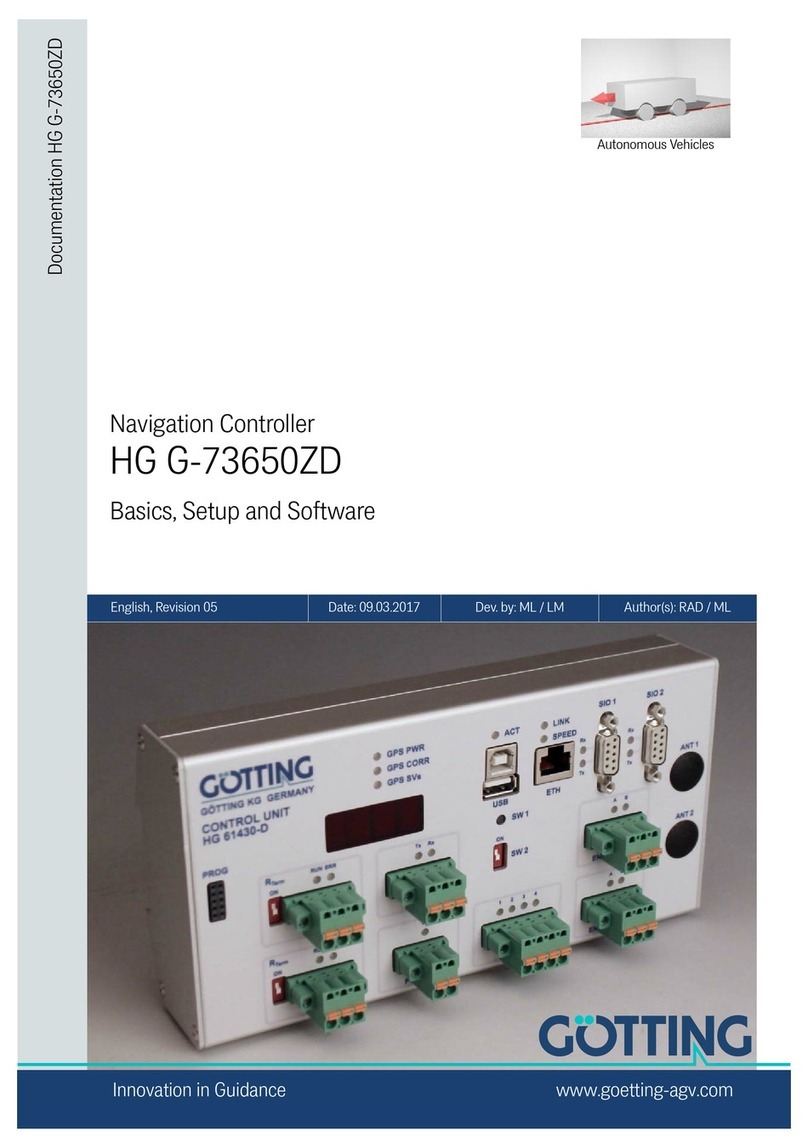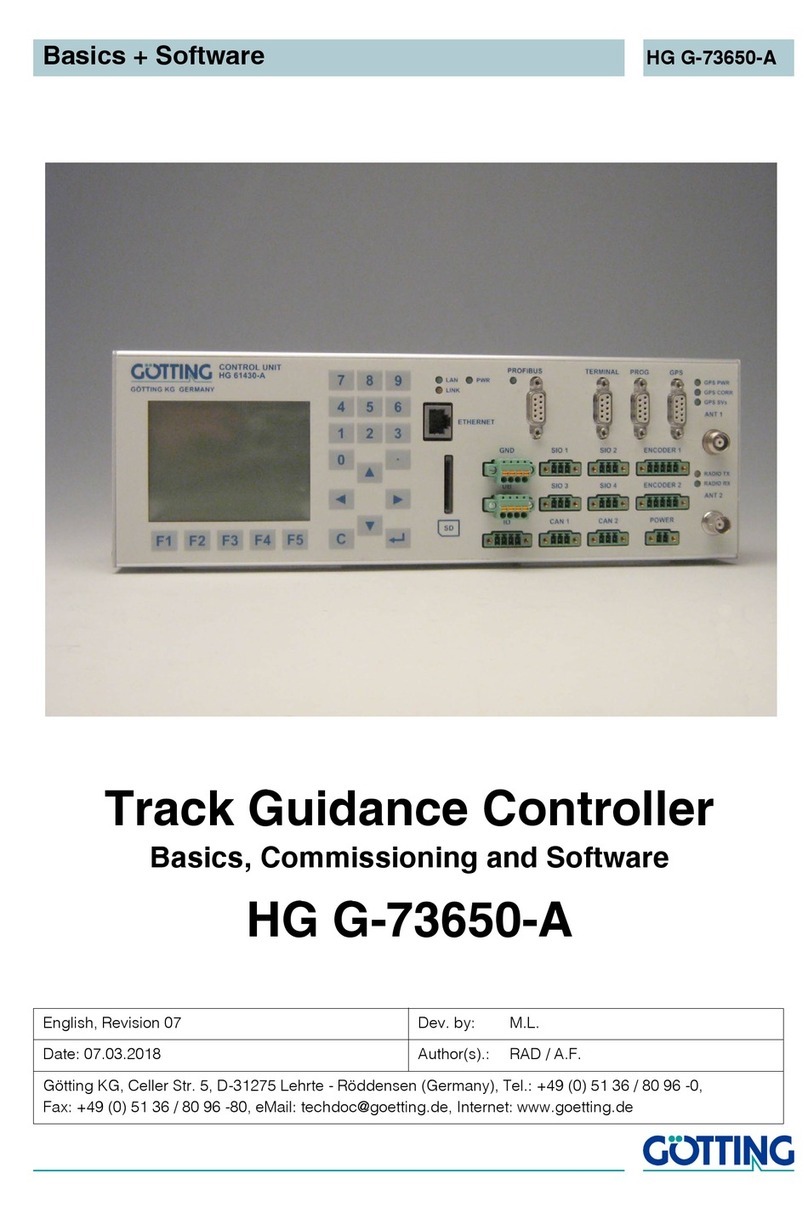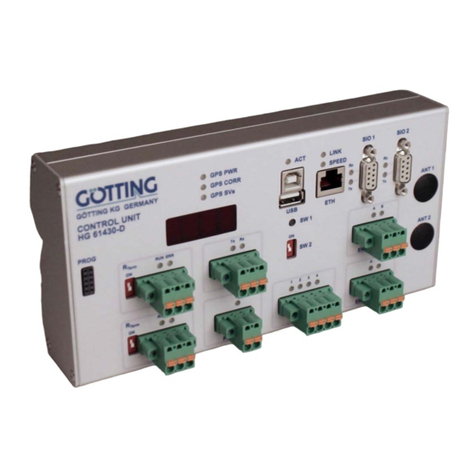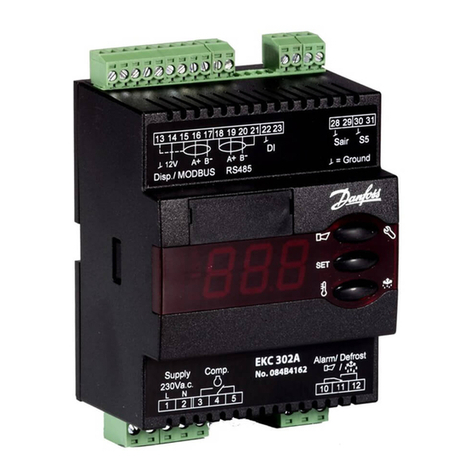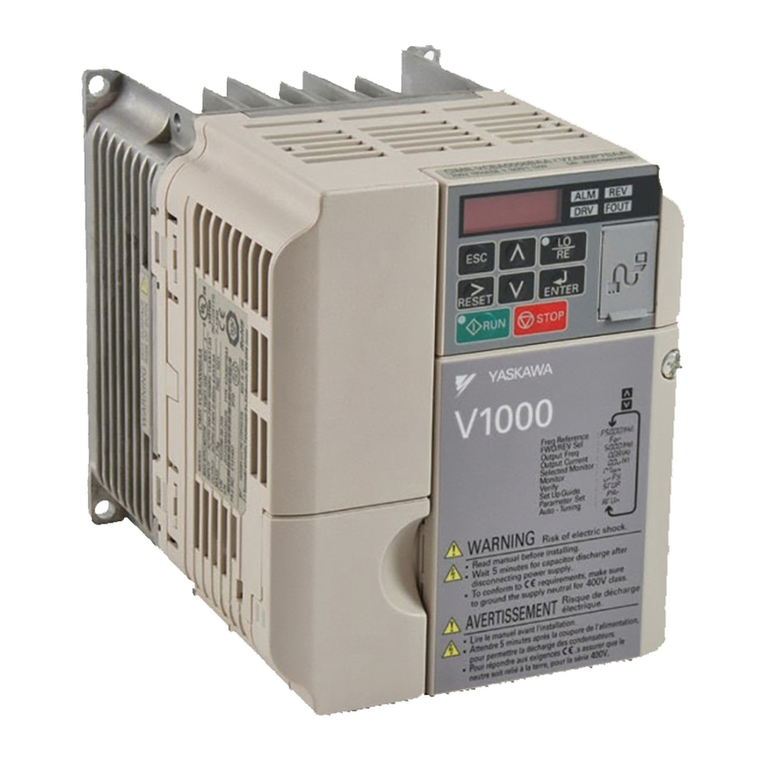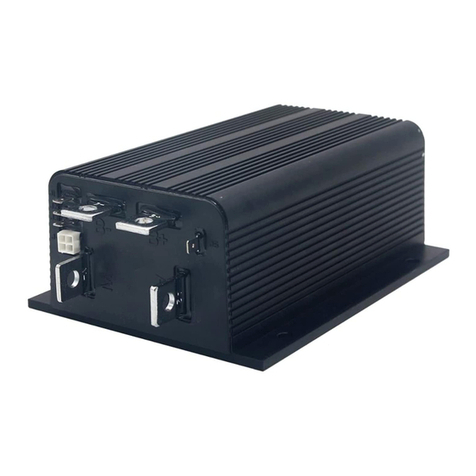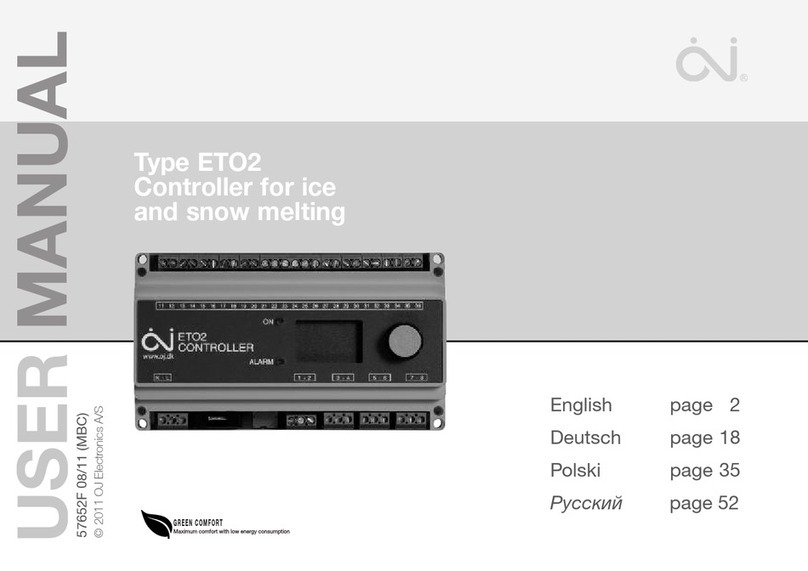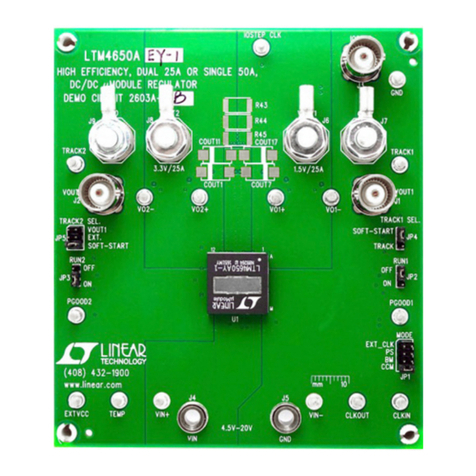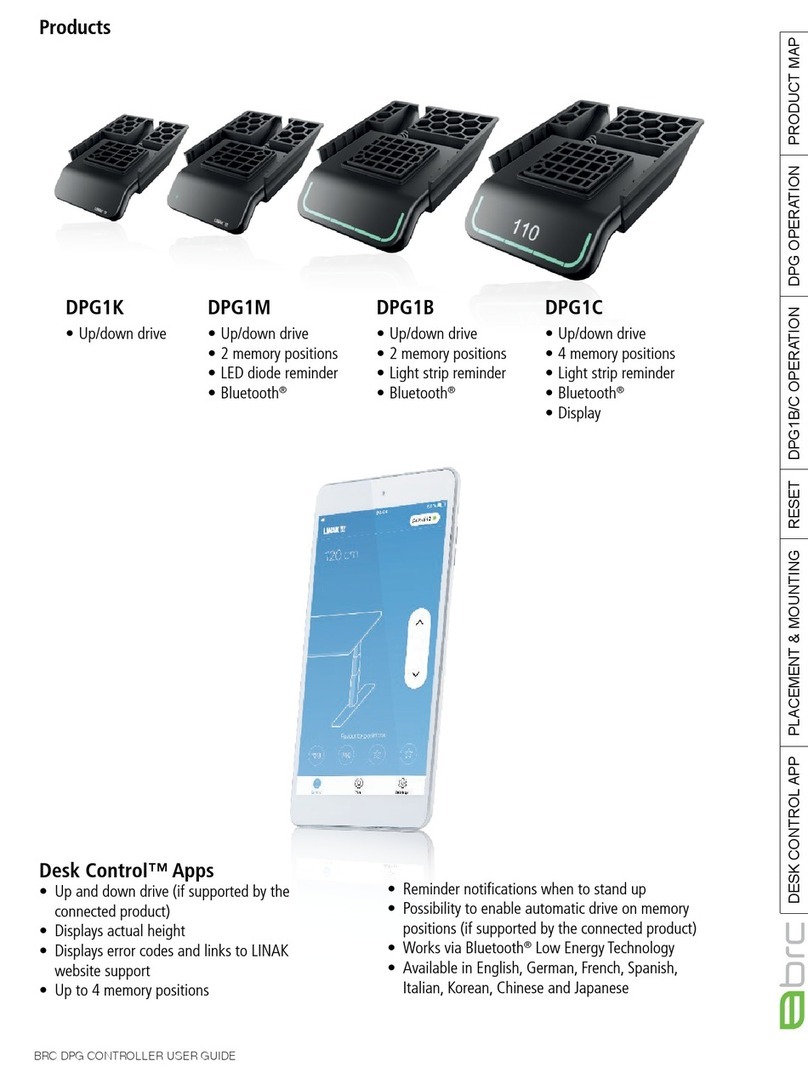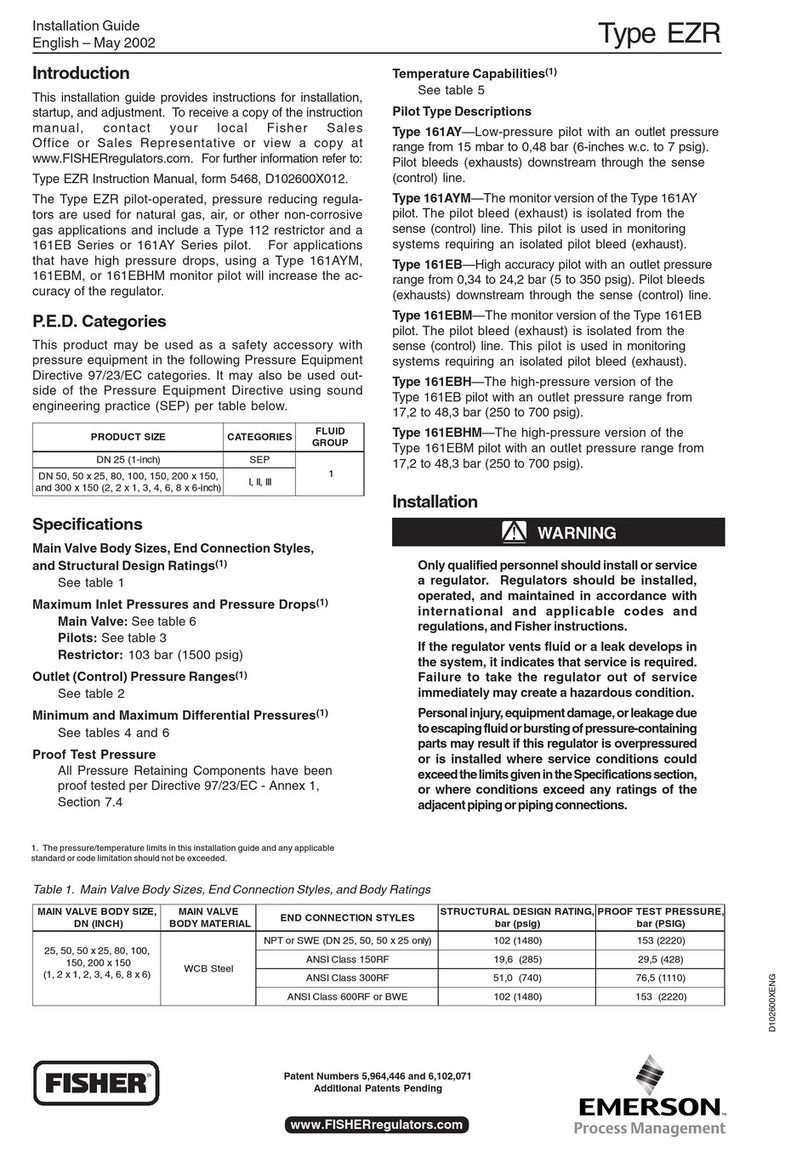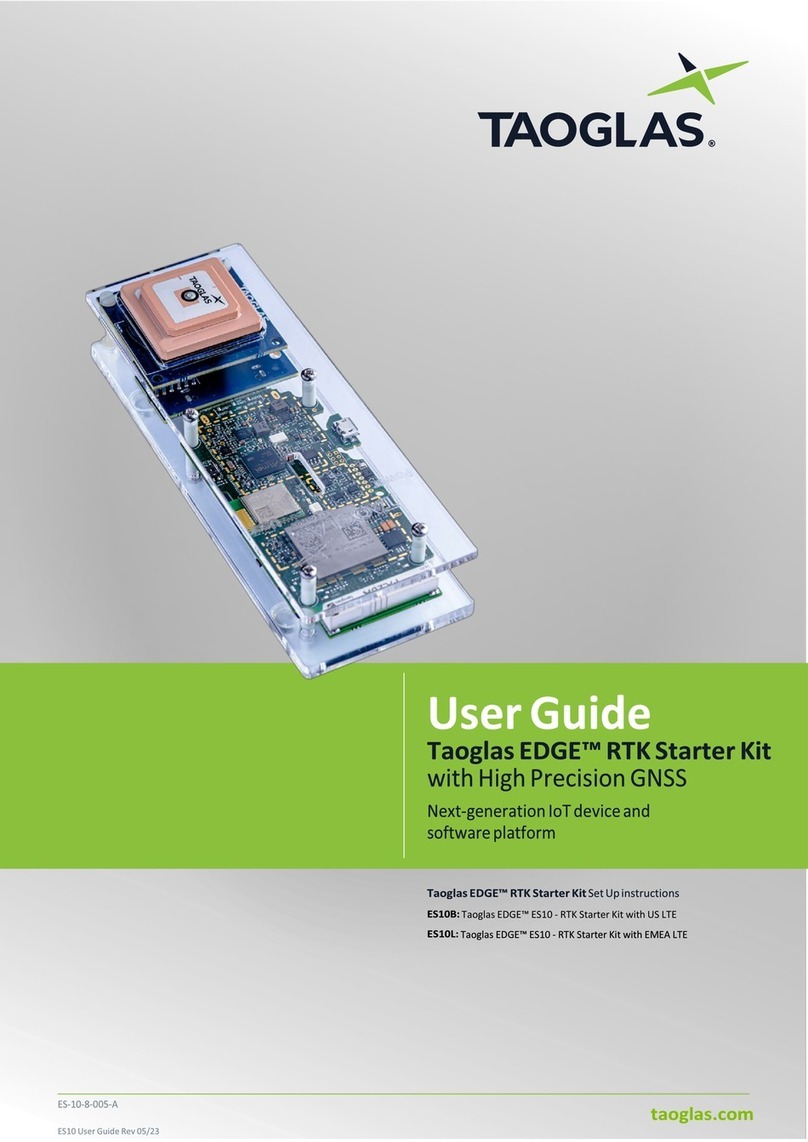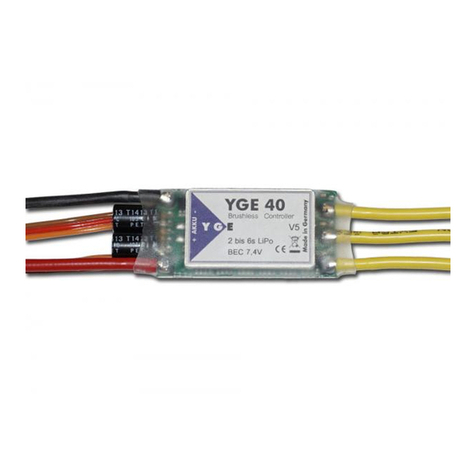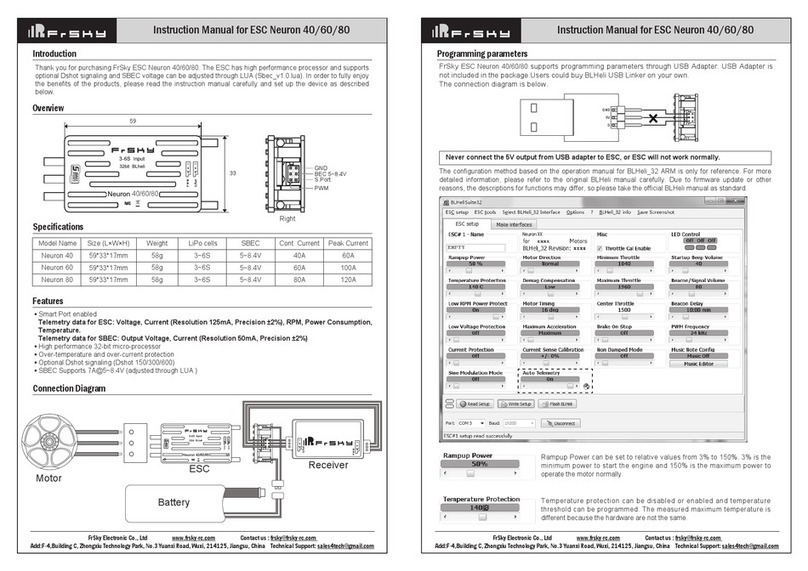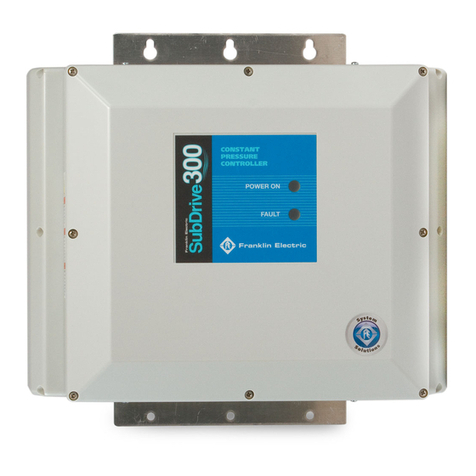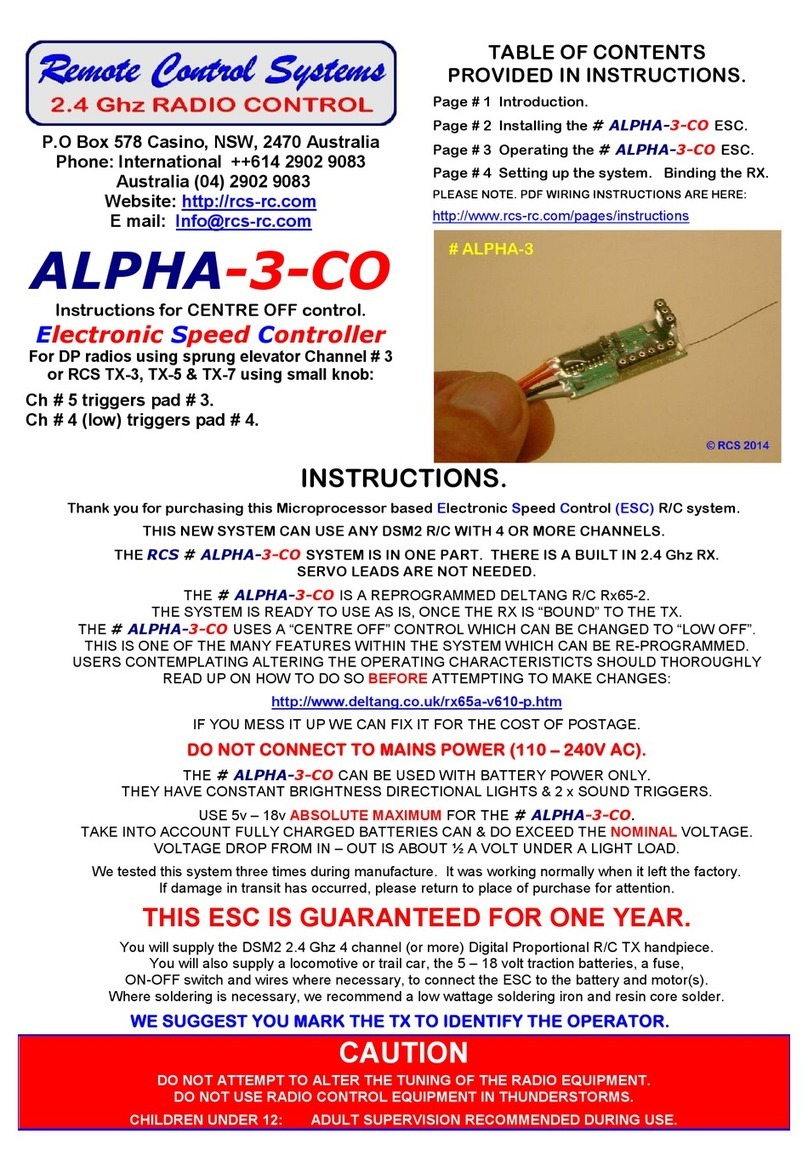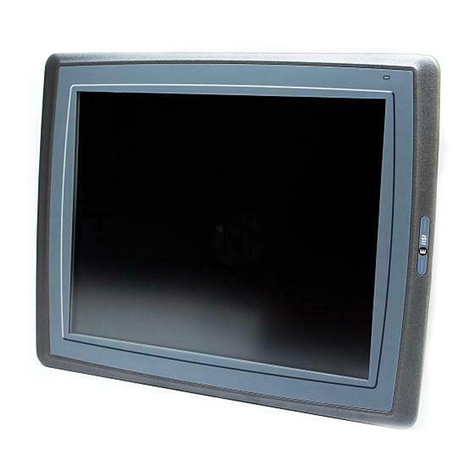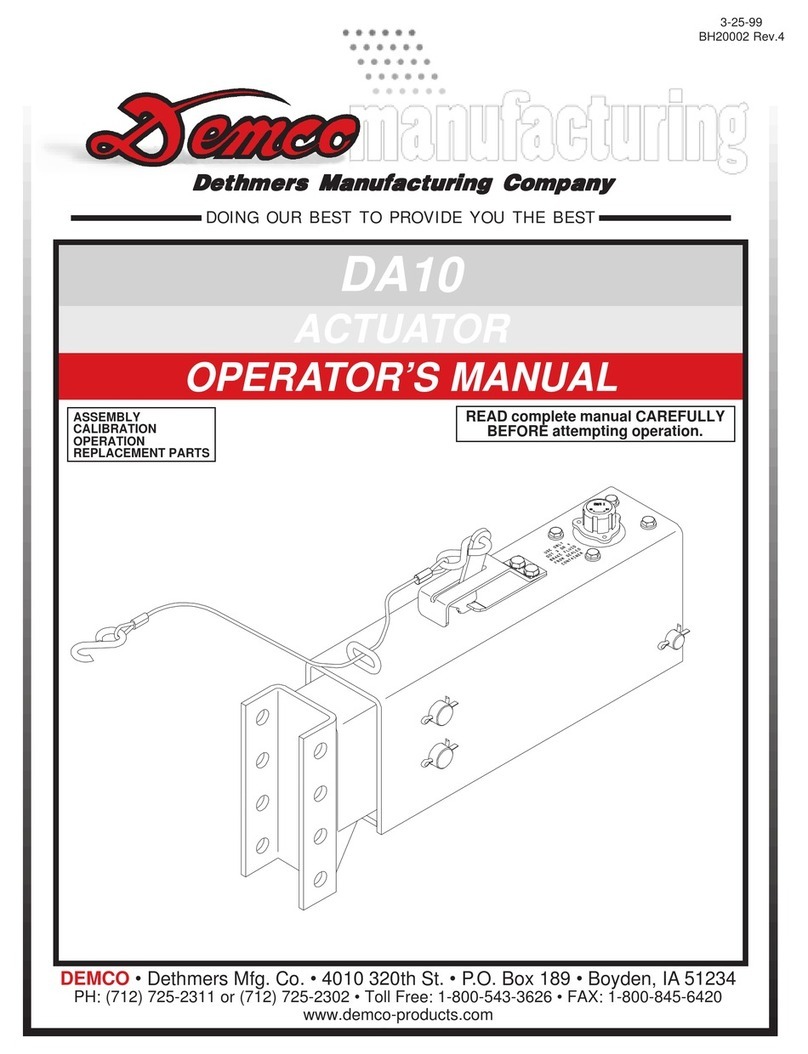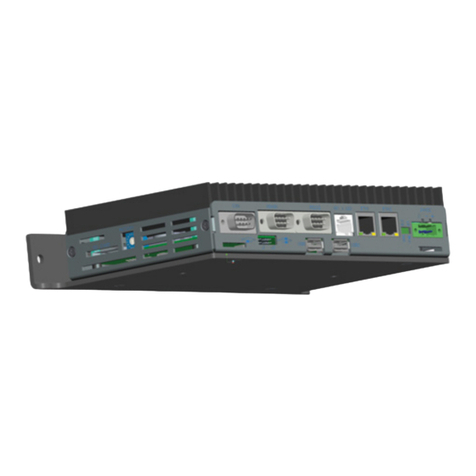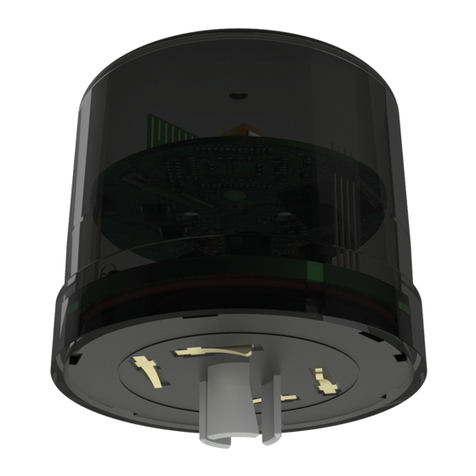Gotting HG G-73650ZD Manual

Documentation HG G-73650ZD | English, Revision 08 | Date: 15.11.2018
3
Table of Contents
Contents
1 Introduction....................................................................................... 8
1.1 Presentation of Information .............................................................................................. 8
1.1.1 Warning Notices ............................................................................................................... 8
1.1.2 Symbols ............................................................................................................................... 9
1.2 Tasks of the Navigation Controller................................................................................10
1.3 Intended Use ........................................................................................................................10
1.4 Requirements / Options....................................................................................................11
2 Basic Principles of Track Guidance ............................................... 12
2.1 Suitable and Unsuitable Vehicle Types........................................................................12
2.2 System Composition..........................................................................................................13
2.3 Position Determination with Sensor Fusion...............................................................13
2.3.1 The Odometry..................................................................................................................14
2.3.2 Freeze ONS.......................................................................................................................14
2.3.3 Compensation of Wheel Diameters..........................................................................15
2.3.4 Sensors for Navigation .................................................................................................15
2.3.4.1 Transponder Antenna ...............................................................................................15
2.3.4.1.1 Single Antenna Evaluation – Calculation of the Position with
one Antenna ............................................................................................................16
2.3.4.1.2 Double Antenna Evaluation ................................................................................18
2.3.4.1.3 The Triple Antenna Evaluation...........................................................................19
2.3.4.1.4 Initialising the Transponder Sensor Fusion (Placing Vehicle on
the Track) .................................................................................................................19
2.3.4.1.5 The Transponder List............................................................................................20
2.3.4.2 The GPS/GNSS System ............................................................................................20
2.4 Coordinate Systems ...........................................................................................................21
2.4.1 The Vehicle Coordinate System.................................................................................21
2.4.2 The Local Coordinate System.....................................................................................22
2.4.3 Characteristics of the Coordinate Systems............................................................22
2.5 Reconstruction of the Route (Segments)....................................................................23
2.5.1 Virtual Tracks ...................................................................................................................23
2.5.2 The Segment File............................................................................................................24
2.5.2.1 Structure of the Segment File................................................................................24
2.5.2.2 The Segment Search.................................................................................................26
2.5.2.3 Selection of Segments .............................................................................................26
2.5.2.4 Transmission of Segments......................................................................................28
2.5.2.5 FTP Transmission of Segments .............................................................................28
2.5.3 Attributes ..........................................................................................................................29
2.5.3.1 Offset Driving ..............................................................................................................29
2.5.3.2 Inverted Steering........................................................................................................31
2.5.3.3 Stop Distance ..............................................................................................................32
2.5.3.4 Spot Turn ......................................................................................................................32
2.5.4 Creating / Editing of a Segment File ........................................................................33
2.6 Track Guidance....................................................................................................................33
2.6.1 Speed Calculation ..........................................................................................................35
2.6.1.1 Ramps in the Navigation Controller .....................................................................35
2.6.1.2 Speed Ramp ................................................................................................................36
2.6.1.3 Stop Ramp....................................................................................................................37
2.6.2 Adjustment of the Speed by the PLC .......................................................................37
2.6.3 Automatic Adjustment of Segment Speeds...........................................................37
2.6.4 Steering Angle Calculation ..........................................................................................38
2.6.5 Guidance of an omnidirectional Vehicle .................................................................38
2.6.6 Guidance of a non-omnidirectional Vehicle ...........................................................39

Documentation HG G-73650ZD | English, Revision 08 | Date: 15.11.2018
4Table of Contents
2.6.7 Reverse Driving with a Trailer.....................................................................................40
2.6.8 Measuring Section..........................................................................................................41
2.6.9 Driving Modes..................................................................................................................42
2.6.9.1 Idle Mode ......................................................................................................................42
2.6.9.2 Parameter Test Mode................................................................................................42
2.6.9.3 Automatic Mode .........................................................................................................42
2.6.9.4 Remote Control Mode...............................................................................................42
2.6.9.5 Vector Steering Mode ...............................................................................................43
2.7 Communication with the Vehicle Control (e.g. PLC)................................................44
3 Hardware .........................................................................................45
3.1 Mounting................................................................................................................................46
3.2 Front Panel............................................................................................................................46
3.3 Control Elements on Front Panel ...................................................................................46
3.4 Display Elements on Front Panel ...................................................................................47
3.5 Connectors............................................................................................................................48
3.5.1 ETH......................................................................................................................................48
3.5.2 USB .....................................................................................................................................48
3.5.3 SIO 1 (GPS Receiver) .....................................................................................................48
3.5.4 SIO 2 ...................................................................................................................................49
3.5.5 CAN 1 .................................................................................................................................49
3.5.6 CAN 2 .................................................................................................................................50
3.5.7 SIO 3 ...................................................................................................................................50
3.5.8 POWER...............................................................................................................................50
3.5.9 IO .........................................................................................................................................51
3.5.10 ENCODER 1 / ENCODER 2...........................................................................................51
3.5.11 PROG ..................................................................................................................................51
3.5.12 ANT1 / ANT2 ....................................................................................................................51
3.6 Extension module Feldbus...............................................................................................52
4 Configuration via Web Sites...........................................................53
4.1 Main menu ............................................................................................................................54
4.2 Status Menu..........................................................................................................................55
4.2.1 Navigation Menu .............................................................................................................55
4.2.1.1 Status .............................................................................................................................55
4.2.1.2 Deviation .......................................................................................................................56
4.2.1.3 Seg. Table .....................................................................................................................56
4.2.1.4 Segment ........................................................................................................................56
4.2.1.5 PLC..................................................................................................................................57
4.2.2 Transponder Menu .........................................................................................................58
4.2.2.1 Antenna .........................................................................................................................58
4.2.2.2 Result .............................................................................................................................59
4.2.2.3 Odometry ......................................................................................................................59
4.2.3 GPS Menu .........................................................................................................................60
4.2.3.1 GPS .................................................................................................................................60
4.2.3.2 ONS.................................................................................................................................60
4.2.3.3 Controller Deviation...................................................................................................61
4.2.3.4 Controller Correction.................................................................................................61
4.2.3.5 Status .............................................................................................................................61
4.2.4 GPS Receiver Menu .......................................................................................................62
4.2.4.1 UTC .................................................................................................................................62
4.2.4.2 Status .............................................................................................................................62
4.2.4.3 Position..........................................................................................................................62
4.2.4.4 Diff. Data Age ..............................................................................................................63
4.2.4.5 Satellites........................................................................................................................63
4.2.4.6 Accuracy........................................................................................................................63
4.2.4.7 Base Vector ..................................................................................................................63
4.2.4.8 Heading .........................................................................................................................63
4.2.5 Error Menu ........................................................................................................................64

Documentation HG G-73650ZD | English, Revision 08 | Date: 15.11.2018
5
Table of Contents
4.2.6 TCP Menu .........................................................................................................................65
4.3 Configuration Menu ...........................................................................................................65
4.3.1 Configuration –> Main ..................................................................................................66
4.3.2 Configuration –> Guidance .........................................................................................68
4.3.3 Wheels ...............................................................................................................................69
4.3.3.1 What type of vehicle is involved? .........................................................................69
4.3.3.2 The non-omnidirectional vehicle...........................................................................70
4.3.3.3 The omnidirectional vehicle....................................................................................71
4.3.3.4 Which wheels should be used for the odometry? ...........................................71
4.3.3.5 How are the positions specified on the vehicle?..............................................71
4.3.3.6 Configuration –> Wheels .........................................................................................72
4.3.4 Configuration –> Antenna ...........................................................................................74
4.3.5 Configuration –> Accuracy..........................................................................................75
4.3.6 Configuration –> Steer Controller .............................................................................76
4.3.7 Configuration –> Speed Controller ...........................................................................78
4.3.8 Configuration –> Sensor Fusion Transponder.......................................................80
4.3.9 Configuration –> Sensor Fusion GPS.......................................................................81
4.3.10 Configuration –> Gyro...................................................................................................83
4.3.11 Configuration –> Servo.................................................................................................84
4.3.12 Configuration –> Trailer ...............................................................................................87
4.4 Network Menu .....................................................................................................................89
4.5 Config File Menu.................................................................................................................90
4.5.1 Upload Configuration ....................................................................................................90
4.5.2 Download ..........................................................................................................................91
4.6 Segment File Menu ............................................................................................................91
4.6.1 Upload Segment File .....................................................................................................91
4.6.2 Download Segment File ...............................................................................................92
4.7 Segment Table Menu ........................................................................................................92
4.8 Transponder File Menu .....................................................................................................93
4.8.1 Upload Transponder File ..............................................................................................93
4.8.2 Download Transponder File ........................................................................................94
4.9 Transponder Table Menu..................................................................................................94
4.10 Parameter Test Menu ........................................................................................................95
4.10.1 Requirements for switching into the different modes........................................96
4.10.2 Possibilities in the 'Idle' mode....................................................................................96
4.10.3 Possibilities in the 'Test' mode...................................................................................97
4.10.4 Possibilities in the 'Auto' mode..................................................................................97
4.10.5 Specification of segments ...........................................................................................97
4.10.6 Setting a starting position ...........................................................................................97
5 Configuration via Terminal Program ............................................. 98
5.1 Connection Establishment ...............................................................................................98
5.2 Main Menu ............................................................................................................................99
5.3 A: Main Monitor Navigation.......................................................................................... 100
5.3.1 Display Output.............................................................................................................. 100
5.3.2 Input Possibilities ........................................................................................................ 102
5.4 B: Main Monitor Sensorfusion ..................................................................................... 103
5.4.1 Display Output.............................................................................................................. 103
5.4.2 Input Possibilities ........................................................................................................ 104
5.5 D: Data Logging................................................................................................................ 105
5.6 E: Parameter Test ............................................................................................................ 106
5.6.1 Display Output.............................................................................................................. 106
5.6.2 Input Possibilities ........................................................................................................ 107
5.7 N: Show Segments.......................................................................................................... 108
5.8 Q: Show Transponder..................................................................................................... 109
5.9 S: Segment Sequences .................................................................................................. 109
6 Commissioning .............................................................................111
6.1 Interfaces usually connected ....................................................................................... 111
6.2 Test / Real Operation...................................................................................................... 111
6.3 Commissioning the communication .......................................................................... 112

Documentation HG G-73650ZD | English, Revision 08 | Date: 15.11.2018
6Table of Contents
6.4 Setting the parameters .................................................................................................. 112
6.4.1 Configuration -> Main ................................................................................................ 113
6.4.2 Configuration –> Guidance....................................................................................... 114
6.4.3 Configuration –> Wheels........................................................................................... 115
6.4.4 Configuration –> Antenna......................................................................................... 117
6.4.5 Configuration –> Accuracy ....................................................................................... 118
6.4.6 Configuration –> Steer Controller .......................................................................... 118
6.4.7 Configuration –> Speed Controller ........................................................................ 119
6.4.8 Configuration –> Sensorfusion Transponder ...................................................... 119
6.4.9 Configuration –> Sensorfusion GPS ...................................................................... 119
6.4.10 Configuration –> Gyro ................................................................................................ 120
6.4.11 Configuration –> Servo .............................................................................................. 120
6.4.12 Configuration –> Trailer............................................................................................. 120
6.5 Creating the segments ................................................................................................... 120
6.6 Simulation without vehicle and vehicle controller ................................................ 121
6.7 Simulation without vehicle and with vehicle controller....................................... 122
6.8 Commissioning a vehicle............................................................................................... 122
6.8.1 Testing and Optimizing the Parameters ............................................................... 123
6.8.2 Other Optimisations.................................................................................................... 126
6.8.3 Optimizing the Steering Controller ........................................................................ 127
6.8.4 Optimizing the Speed Ramps .................................................................................. 128
7 CAN Bus Protocol......................................................................... 130
7.1 How to send Segments to the Control Unit via the CAN Bus ............................ 130
7.2 Transmission Telegrams from Control Unit to PLC, the Wheels and
the Gyro .............................................................................................................................. 132
7.2.1 Status Box...................................................................................................................... 132
7.2.2 Path Data Box ............................................................................................................... 132
7.2.3 Segment Search Box .................................................................................................. 134
7.2.4 Error Box......................................................................................................................... 135
7.2.5 Sensorfusion Boxes .................................................................................................... 140
7.2.6 Wheel Boxes.................................................................................................................. 141
7.2.7 CAN Open Start / Stop Box ...................................................................................... 142
7.2.8 Servo Box ....................................................................................................................... 143
7.2.9 Gyro Box ......................................................................................................................... 143
7.2.10 Angle and Speed Box ................................................................................................. 144
7.2.11 ME1 Box ......................................................................................................................... 144
7.2.12 ME2 Box ......................................................................................................................... 145
7.2.13 Pol X/Y CAN2 Box........................................................................................................ 145
7.2.14 Polar CAN 1 / CAN 2 / CAN 1+2 Box ..................................................................... 146
7.3 Reception Telegrams from PLC, Wheels, Antennas, Gyro and Sen-
sor Fusion to the Control Unit...................................................................................... 146
7.3.1 PLC Control Box ........................................................................................................... 146
7.3.2 Path data (target) Box ................................................................................................ 148
7.3.3 Remote Control Box.................................................................................................... 149
7.3.4 Wheel Box...................................................................................................................... 150
7.3.5 Servo Box ....................................................................................................................... 151
7.3.6 Antenna Boxes.............................................................................................................. 151
7.3.7 Gyro Box ......................................................................................................................... 152
7.3.8 Sensor Fusion Boxes .................................................................................................. 153
7.3.9 Vector Box...................................................................................................................... 155
7.3.10 Steering Encoder Box................................................................................................. 156
7.3.11 Contelec Steering Encoder Box .............................................................................. 156
7.3.12 ME PDO 1 Box .............................................................................................................. 156
7.3.13 ME PDO 2 Box .............................................................................................................. 157
7.3.14 ME PDO 3 Box .............................................................................................................. 157
7.3.15 Wheel Reduction Box................................................................................................. 157
7.3.16 Trailer Box...................................................................................................................... 158
7.3.17 Segment Sequence Box ............................................................................................ 158
8 Feldbus/Ethernet (UDP) Output .................................................. 160
8.1 Tx Transmission Telegram Control Unit –> PLC .................................................... 160

Documentation HG G-73650ZD | English, Revision 08 | Date: 15.11.2018
7
Table of Contents
8.2 Rx Reception Telegram PLC –> Control Unit.......................................................... 166
9 USB Data Logging: Scope of the Data ........................................ 171
9.1 Opening logged Data in Excel® .................................................................................. 171
9.2 List of Logged Parameters............................................................................................ 172
10 Trouble Shooting ..........................................................................185
11 Technical Data ..............................................................................187
12 Appendix........................................................................................188
12.1 Attributes............................................................................................................................ 188
12.2 Steering via Segment Sequences............................................................................... 189
12.2.1 Definition of Segment Sequences ......................................................................... 189
12.2.2 Starting Segment Sequences .................................................................................. 190
12.3 Radius Calculation with 16 Bit Resolution............................................................... 190
12.4 Configuration of the Ethernet Interface Parameters via SIO 2 ......................... 191
12.5 Firmware-Update via the USB Interface................................................................... 192
13 List of Figures ...............................................................................196
14 List of Tables.................................................................................199
15 Index ..............................................................................................202
16 Copyright and Terms of Liability .................................................205
16.1 Copyright ............................................................................................................................ 205
16.2 Exclusion of Liability....................................................................................................... 205
16.3 Trade Marks and Company Names ............................................................................ 205

Documentation HG G-73650ZD | English, Revision 08 | Date: 15.11.2018
8Chapter 1 – Introduction
1Introduction
The subject of this manual is the Navigation Controller HG G-73650ZD that enables
AGV (Automated Guided Vehicles) to follow virtual tracks. The following terms are
used synonymously throughout this document:
Control Unit (as printed onto the hardware)
navigation controller
Vehicle Guidance Controller (VGC)
1.1 Presentation of Information
For you to be able to use your product simply and safely this device description uses
consistent warning notices, symbols, terms and abbreviations. Those are described
in the following sections.
1.1.1 Warning Notices
In this device description warning notices appear before sequences of actions that
may lead to damage to persons or property. The listed actions for the danger preven-
tion have to be observed.
Warning notices have the following structure:
The warning symbol (warning triangle) indicates danger to life or risk of injury.
The signal word indicates the severity of the danger.
The paragraph kind or source of the danger names the kind or source of the
danger.
The paragraph consequences describes the consequences of not observing
the warning notice.
The paragraphs for danger prevention explain, how to avoid the danger.
SIGNAL WORD
Kind or source of the danger
Consequences
Danger prevention

Documentation HG G-73650ZD | English, Revision 08 | Date: 15.11.2018
9
Introduction – Chapter 1
The signal words have the following meanings:
1.1.2 Symbols
In this device description the following symbols and formatting are used:
If this information is ignored,
the product may not be operated in an optimal way.
Indicates one or more links to the Internet.
–www.goetting.de/xxx
–www.goetting.de/yyy
Indicates tips for easier
operation of the product.
The check mark lists a requirement.
The arrow shows an action step.
The indentation shows the result of an action or an action sequence.
Program texts and variables are indicated through the use of a fixed width
font.
Menu items and parameters are shown in cursive characters.
Whenever the pressing of letter keys is required for program entries, the
required etter eys are indicated as such (for any programs of Götting KG
small and capital letters are equally working).
Table 1 Hazard classification according to ANSI Z535.6-2006
Warning Symbol, Signal Word Meaning
DANGER
DANGER indicates a hazardous situation
which, if not avoided, will result in death or
serious injury.
WARNING
WARNING indicates a hazardous situation
which, if not avoided, could result in death or
serious injury.
CAUTION
CAUTION indicates a hazardous situation
which, if not avoided, could result in minor or
moderate injury.
NOTICE
NOTICE indicates property damage: The
product or the environment could be dam-
aged.

Documentation HG G-73650ZD | English, Revision 08 | Date: 15.11.2018
10 Chapter 1 – Introduction
1.2 Tasks of the Navigation Controller
The navigation controller has the following tasks:
1. Determination of the current position via transponders, GPS or external input,
see section 2.3 on page 13
2. Reconstruction of the route to be driven (by means of segment files), see sec-
tion 2.5 on page 23
3. Track Guidance (controlling the vehicle on a track), see section 2.6 on page 33
As the navigation controller is a very complex technical product the following pages
will first cover the various aspects of the vehicle's track guidance that have to be
considered before we explain the subject areas of commissioning and configuration.
The following points will be explained later in this manual:
Basic information on positioning, track creation and track guidance
Hardware description, including displays and interfaces
Software description, including all menus of the web configuration
Commissioning
Protocol description, structure of the CAN- telegrams, Feldbus (external imple-
mentation on profinet, profibus, etc.)
Listing of data, which can be logged on an USB stick for analysis purposes
Trouble shooting
1.3 Intended Use
Due to its design the navigation controller is designated for a wide scope of applica-
tions. It can only be applied for the track guidance of vehicles if the manufacturer or
the plant operator ensure that sensors for position detection are used that are suit-
able for the requirements of that specific place and thus work fully (GPS e.g. is only
suitable for outdoor environments with the restriction that the GPS signals experi-
ence no interferences due to occlusions).
Furthermore it is essential that all parameters, e.g. concerning the vehicle's dimen-
sions and functions as well as the position of the axles and wheels have to be en-
tered with utmost accuracy. Consequently for new projects a comprehensive testing
of the settings with a jacked-up vehicle within a closed down section of the plant is
always recommended.
DANGER
Danger through missing safety measures
The navigation controller HG G-73650ZD is not a safe device.
Only use the navigation controller in applications where sufficient additional
precautions for the protection of people and the detection of obstacles have
been taken.

Documentation HG G-73650ZD | English, Revision 08 | Date: 15.11.2018
11
Introduction – Chapter 1
1.4 Requirements / Options
If you want to use the internal sensor fusion, at least one rotary encoder or any
other velocity or distance determining sensor has to be in operation. When
rotary encoders are directly connected to the steering controller please ensure
that it is a push/pull type with an output voltage of 5 to 25 V, two tracks perpen-
dicular to each other and a resolution of 0.1 to 1 mm / pulse. Using data tele-
grams on the bus it is also possible to work with encoders to which this
limitation does not apply. For an improved accuracy or to achieve redundancy
you can also use the Gyro HG G-84300 (according to odometry).
If a transponder positioning system is to be used, its antennas can be con-
nected via CAN bus. Alternatively or in connection with the transponder system
you can use a GPS system.
When using the laser scanner HG G-43600 two rotary encoders and two
steering encoders have to be connected directly to the navigation controller or
deliver their data via the wheel telegrams on the bus.
Some steering servos and motor control units can be controlled / addressed
directly by the navigation controller so that a vehicle control system for each
individual application (e.g. PLC) is not absolutely necessary for each application.
However, in terms of monitoring, redundancy and customized adaptions a vehi-
cle control system is always recommendable for larger vehicles.
If emergency stop functions are to be provided, a vehicle control system is man-
datory as the highest possible safety can only be achieved when both steering
controller and vehicle control system are installed.
WARNING
Danger through incorrect parameters/faulty input signals
Vehicles using the navigation controller usually drive fully automated during their
final / last implementation step. In case that incorrect parameters or fully input
signals are used there is a danger of damages to the vehicle or its environment
(including persons).
Only use the navigation controller in applications where sufficient additional
precautions for the protection of people and the detection of obstacles have
been taken.
The vehicle manufacturer as well as the plant operator are obliged to operate
with the greatest care.
Inform all persons entrusted with carrying out work within or close to the
area of automated operation.
Follow the procedure described in chapter 6 „Commissioning“ on page 111
and test all parameter changes within closed down sections with a jacked-up
vehicle.

Documentation HG G-73650ZD | English, Revision 08 | Date: 15.11.2018
12 Chapter 2 – Basic Principles of Track Guidance
2Basic Principles of Track Guidance
2.1 Suitable and Unsuitable Vehicle Types
The range of particularly suitable vehicle types covers all vehicles that operate pre-
dictably and reproducibly. Several non-steered axles, trailers or vehicles with a cen-
ter pivot steering are not suitable.The wheel slippage has to be low and the wheels
should be hard to minimize the friction.
Figure 1 Example: Suitable vehicle types (selection)
The sketch below shows simplified versions of all the vehicles as three-wheelers, be-
cause this is the base vehicle model used by the navigation controller. The navigation
controller can also be used for vehicles where the steered wheel is not in the middle
(e.g. some fork-lift truck types).
Figure 2 Sketch: Suitable vehicle types
One fixed axle
particularly
suited
e.g. fork-lift
truck
Symmetrical
steering
particularly
suited
e.g. some heavy
duty vehicles
Two fixed axles
less accuracy and
partly rubbing,
grinding wheels
e.g. large towing
tractors
Coordinate
chassis / omni-
directional ve-
hicles
particularly
suited
e.g. special
vehicles
Trailer
less accuracy and part-
ly rubbing, grinding
wheels
e.g. Trucks with semi-
trailer

Documentation HG G-73650ZD | English, Revision 08 | Date: 15.11.2018
13
Basic Principles of Track Guidance – Chapter 2
2.2 System Composition
Figure 3 Block diagram system structure
Due to the strict separation of the track controller, sensor fusion and navigation sys-
tem and the smart interaction with the vehicle control, the navigation controller of-
fers a high degree of flexibility and is also suitable for monitoring safety-critical ve-
hicle components.
2.3 Position Determination with Sensor Fusion
The sensor fusion calculates the current position and the vehicle's orientation. The
sensor fusion provides the steering controller with the following data set (also re-
ferred to as pose):
X Position
Y Position
Speed
Vehicle orientation
If the internal sensor fusion is used, the position of the vehicle is calculated from the
odometry, initialized and corrected by the transponder antenna and/or the GPS sys-
tem. The transponder antennas will then be connected via CAN bus. Additionally
their posi pulse has to be connected with IO-3 (see manual of the antenna). The op-
tional Gyro is connected via CAN bus as well and is intended to enhance the odo-
metry.
Since odometric calculations tend to be load-dependent the installation of a Gyro is
recommended.
IO 1-3
A/B
A/B
Navigation Controller
Incremental
Encoder
(optional)
Incremental
Encoder
(optional)
Hardware Control Unit HG 61430
Gyro
HG 84300
(optional)
Transponder-Antenna
HG 98810 / HG 98820 /
HG 98850
(up to 4, optional)
GPS Antennas 1 & 2 (optional)
Track
Guidance
Controller
Vehicle PLC
Internal
Sensor fusion
Transponder
and/or GPS
IO 4
Central
Control
Unit
Narrow-band
RF Modem
(optional)
Narrow-band
RF Modem
(optional)
Steering Servo
Acceleration
(optional)
Break (optional)
Emergency Stop
(optional)
External
Sensor Fusion
e.g. Laser Scanner
(optional)

Documentation HG G-73650ZD | English, Revision 08 | Date: 15.11.2018
14 Chapter 2 – Basic Principles of Track Guidance
If an external sensor fusion (determination of position and angle) shall be applied it
can be connected via the CAN Bus. The relevant protocol is described in chapter 7
on page 130. This may be e.g. laser scanner HG 43600. As long as they are compli-
ant with the CAN Bus protocol requirements it is possible to use other position- de-
termination systems as well.
By the use of a short-term stable odometry in combination with an absolute position
sensor the advantages of both systems are united. The absolute position sensor ini-
tializes the odometric data and thus provides both the position as well as the vehicle
heading at every point. During operation the cumulative inaccuracies in the odo-
metry will be reset at those points where an absolute position is available.
In addition to the position and the steering angle the sensor fusion provides the
speed as well as an accuracy estimation. This estimation is based on the accuracy
table (see Table 72 on page 155). The table is structured in such a way that the error
is small right after e.g. a transponder has been passed over. With the distance trav-
eled the error tends to grow more rapidly, as the angle is also steadily worsening. So
with every meter travelled the value of the accuracy assessment is decreased by one
position, i.e. it moves one line upwards in the corresponding Table 72.
When using GPS technology the GPS system determines the position's estimated
accuracy in meters. If GPS and transponder antennas are used simultaneously the
accuracy estimation is defined by the system in use. Switching between systems
can be automated via accuracy thresholds or set manually via segment specific at-
tributes.
2.3.1 The Odometry
The odometric system uses wheel rotations, the steering angle and/or a Gyro to de-
termine the change in vehicle position and vehicle heading.
The odometry has the advantage to be highly accurate over short distances and to
supply the vehicle position at any time. The odometry has to be initilized at start-up.
However while traveling longer distances the system immanent errors accumulate.
This can cause considerable deviations.
2.3.2 Freeze ONS
ONS = Odometric Navigation System – Calculation of the vehicle position via veloc-
ities nad steering angles. For some vehicles a speed is shown even though the vehi-
cle stands still. This can e.g. happen when a Diesel engine produces vibrations. The
positive and negative speeds caused by this lead to calculated positions that also
jump. In the long term the calculated position moves away from the actual position
due to rounding errors. This can be prevented by using the function Freeze ONS.
If a wheel is moving faster than 0.1 m/s while the function is activated the con-
trol unit triggers a plausibility error (0x0400) since it has to assume that the
vehicle in fact moves. Additionally the accuracy of the position is set to 100 m.
WARNING
Risk of collision
In case the vehicle does move slowly while the control unit receives the Freeze
ONS signal the control unit uses wrong position data from the position the
vehicle had when Freeze ONS was activated.
This function may only ever be used when the vehicle is standing still and the
brake is activated.

Documentation HG G-73650ZD | English, Revision 08 | Date: 15.11.2018
15
Basic Principles of Track Guidance – Chapter 2
For speeds below 0.1 m/s with Freeze ONS activated the control unit can‘t
determine whether the vehicle moves or whether vibrations induce fake
speeds. A collision of the vehicle has to be prevented by the external safety sys-
tem.
When this function is activated by setting the bit Freeze ONS (s. Control Box
Byte 1 Bit 0, see section 7.3.1 on page 146) the position is not re-calculated. As
soon as the control unit gives the vehicle a drive command (in any mode where
the control unit calculates a target speed unlike zero) the Freeze ONS bit is
ignored.
2.3.3 Compensation of Wheel Diameters
With this function the wheel diameters of the vehicle can be compensated accord-
ing to the current load. If the load of the vehicle is specified the unloaded and loaded
wheel diameters can be measured during commissioning. With those values the
wheel diameter can be reduced (compensated) when the vehicle is loaded.
In order to be able to use this function the ID for the corresponding CAN message
has to be set in the general parameter file. For this download the parameter file to a
PC (see section 4.5.2 on page 91) and edit it in a text editor. The parameter with the
name U32_WHEEL_REDUCTION_ID can be found in the last quarter of the param-
eter file. Change the accompanying value to the ID of the CAN message (decimal no-
tation). Setting this to 0 disables the function. The edited parameter file has to be up-
loaded to the navigation controller (see 4.5.1 on page 90).
If the message is activated it has to be transmitted cyclically at least every 500 ms.
Otherwise the navigation controller throws an error.
In the CAN message that is evaluated when this function is enabled the compensa-
tion of the individual wheel diameters is expected as an unsigned char, see section
7.3.15 on page 157. The resolution is 0.1% of the wheel diameter. If e.g. the value
for wheel 2 is set to 15 the effective wheel diameter of wheel 2 is reduced by 1.5%.
In der CAN Nachricht, die bei Aktivierung der Funktion ausgewertet wird, stehen die
Reduzierungen der einzelnen Räder als unsigned char, siehe Abschnitt 7.3.15 on
page 162. Die Auflösung entspricht 0.1% des Raddurchmessers. Wird zum Beispiel
als Wert für das Rad 2 eine 15 eingetragen, wird der wirksame Raddurchmesser von
Rad 2 um 1,5% reduziert.
2.3.4 Sensors for Navigation
2.3.4.1 Transponder Antenna
The transponder system outputs the position and the code of the transponder cur-
rently located underneath the antenna. The position lateral to the direction of travel
has an accuracy between ± 5mm and ±20mm, depending on the antenna type
(mostly its size). Also depending on the antenna type the detection range is between
±125 and up to ± 500mm, the reading distance varies between 50 - 200 mm. Pos-
sible antennas are e.g. the Götting types HG G-98810, HG G-98820, HG G-98830
and HG G-98850.
The transponder position in direction of travel is only output as the posi pulse when
the center of the transponder antenna is crossing the transponder. When there is no
transponder underneath the antenna, the antenna delivers no position. There may
be at most one transponder underneath the antenna at any given time. The
parameters of the transponder antenna are set via a RS 232 interface which is de-
scribed in the antenna manual.

Documentation HG G-73650ZD | English, Revision 08 | Date: 15.11.2018
16 Chapter 2 – Basic Principles of Track Guidance
Figure 4 Determination of antenna positions underneath the vehicle
The transponder antennas are 1.5 dimensional. That means that the relative tran-
sponder position in direction to the long side of the antenna is measured. In direction
of the short antenna side only the crossing impulse (posi pulse) is available, which is
generated when the transponder passes the center of the antenna. The navigation
controller associates a certain task with each antenna number:
Antenna 1: Front (if needed)
Antenna 2: Vehicle center, rotated by 90o(if needed)
Antenna 3: Rear
2-dimensional antennas (like the Götting model HG G-98830) are an exception to
the rules above. They replace antenna 1 & 2. Here the posipulse is generated by the
antennas 1 & 3.
The simplest form is a set-up with a single antenna.
2.3.4.1.1 Single Antenna Evaluation – Calculation of the Position with one
Antenna
Figure 5 Single antenna: Placement
In order to be able to calculate a position it is normally necessary to detect more than
one transponder!
The transponder antenna is able to determine the transponder position underneath
the antenna, however the direction of the antenna with regards to the transponder
cannot be determined. (exception: The transponder – a start transponder – can
only be approached in one direction, e.g. at a transfer station). Thus it is necessary
to cross two transponders in order to define the position of the vehicle. The odo-
metry additionally measures the track between these two transponders. The tran-
sponder table enables associating absolute positions with the individually measured
points (transponders). With the reading of two transponders it is then also possible
to determine the direction of the vehicle.
Vehicle X
Vehicle Y
Front
Antenna 1
Antenna 2
Antenna 3
Ant 3
Position X
Ant 3
Position Y
Ant 1
Position Y
Ant 1
Position X
Ant 2
Position X
Ant 2
Position Y
Vehicle X
Antenna 3
Vehicle Y
Front

Documentation HG G-73650ZD | English, Revision 08 | Date: 15.11.2018
17
Basic Principles of Track Guidance – Chapter 2
A fundamental disadvantage of the single antenna is that the calculated orientation
of the vehicle depends on the distance covered between the transponders. However,
the determination of this distance can only be as precise as the vehicle's odometry.
Thus the accuracy of the calculation not only depends on the antenna and the tran-
sponders but also on the odometry. Subsequently this calculation is not as accurate
as the measurement accuracy guaranteed if two antennas read two transponders si-
multaneously.
For non-omnidirectional vehicles make sure that the antenna is always mounted as
close as possible to the fixed axle. If this installation proves to be difficult or isn't fea-
sible at all, the antenna has to be located as close as possible to the fixed axle in the
main direction of travel. The further away the antenna is from the fixed axle the less
accurate the measurement will be. (Lever arm, high transversal speed of the tran-
sponders in curves and reduced effective detection range in curves).
Example
Figure 6 Properties of a single antenna set-up
Antenna properties:
The orange area of the antenna represents the range where max. one transpon-
der may be located. This area lies within a distance of approx. 50 mm around
the antenna casing.
The blue area is the antenna casing (here HG98820 180 mm x 360 mm)
The green area is the reception area of the transponder antenna (here approx.
±50 mm x ±125 mm)
If the thicker red line in the center of the antenna is crossed by a transponder, a
posi pulse will be triggered.
The example shows two possible mounting positions of the antenna on the vehicle.
The first position is 100 mm in front of the fixed axle (turquoise), the second one is
1500 mm in front of the fixed axle (magenta). In both cases the vehicle drives around
a curve with a radius of 500 mm. The example clearly shows that the first position
is much better than the second one:
The antenna's effective reading range for the first position is still 224 mm, for
the second position the range is reduced to 78 mm.
The reading accuracy of the first position is considerably higher. In both cases
the vehicle uniformly turns 4o(it turns with the same speed). The transponder
readings are displayed symmetrically to the posipulse. In position 1 the tran-
sponder is read in a distance of 3,19 mm from the desired position (center of
the antenna), in position two with a reading error of 52,04 mm.
78,84
244,85
500
100
1500
4
°
4°
3,19
52,04

Documentation HG G-73650ZD | English, Revision 08 | Date: 15.11.2018
18 Chapter 2 – Basic Principles of Track Guidance
As the transponder moves much faster through the reading area in position two
due to the bigger lever, the error rate, generated by the timing, will increase.
Major corrective movements may lead to completely missing the transponder in
position two.
If it is not possible to install the antenna close to the fixed axle, e.g. on a fork-lift, the
following should be observed:
It should not be attempted to read transponders in tight turns. It is better to
place a pair of transponders with a distance of at least 0.5 m before and after
the curve.
Where curves are to be driven that are so long that transponders have to be
read, the radius has to be kept to the maximum possible and the speed should
be as lowered as much as possible.
The transponder antenna has to be mounted as close as possible to the rear
axle (fixed axle or fixed roller).
For omnidirectional vehicles make sure that the antenna is mounted as close as pos-
sible to the center of the vehicle. Again the following applies: The more tilted the ve-
hicle moves the more restricted the measurement is. If the vehicle only drives in di-
agonal direction a calculation cannot be performed at all, since the transponders are
no longer crossing the antenna center and consequently no posi pulses are gener-
ated. For each transponder crossing only one calculation is performed (posi pulse of
the transponder).
2.3.4.1.2 Double Antenna Evaluation
Figure 7 Properties of a double antenna set-up
The double antenna set-up has the advantage that the vehicle orientation can be di-
rectly measured using the second antenna. To do so the transponders have to be laid
in such a manner that both antennas are simultaneously located above a transpon-
der each and that antenna 1 or 3 will trigger a posi pulse. Then the calculation is in-
dependent from the odometry. Furthermore the accuracy, especially of the vehicle
orientation, is much more precise in comparison with the evaluation of a single an-
tenna. The antennas should be mounted as far apart as possible. This means that
small inaccuracies during positioning will only have a slight impact on the angle er-
ror. For each transponder crossing only one calculation is performed (posipulse of
antenna 1,3).
Vehicle X
Vehicle Y
Front
Antenna 1
Antenna 3

Documentation HG G-73650ZD | English, Revision 08 | Date: 15.11.2018
19
Basic Principles of Track Guidance – Chapter 2
2.3.4.1.3 The Triple Antenna Evaluation
Figure 8 Properties of a triple antenna set-up
In contrast to the single and double antenna set-up in this application all degrees of
freedom of the vehicle are measured directly. Calculations can be executed as long
as all antennas are positioned above transponders at the same time. This set-up also
allows the determination of the vehicle's position and orientation when driving diag-
onally. Antenna 1 and 3 determine the orientation and Y position, antenna 2 deter-
mines the vehicle's X position (vehicle coordinate system). If only antenna 1 and 3
are located above transponders, the position will be calculated when antenna 1 or 3
generate a posi pulse (like when using a double antenna set-up).
Alternatively one 2-dimensional antenna can either replace antennas 1 & 2 or 2 & 3,
e.g. the Götting model HG G-98830. The antenna‘s second dimension replaces the
tasks of antenna 2.
2.3.4.1.4 Initialising the Transponder Sensor Fusion (Placing Vehicle on the
Track)
There are several options for the initialisation of the transponder sensor fusion:
1. Single antenna set-up:
–The vehicle reads a special start transponder. The start transponder is a nor-
mal transponder which can only be read with a certain orientation due to
constructional measures. This may be e.g. at a transfer station. The start
transponder is marked accordingly in the transponder list and the start head-
ing is recorded in 1/100° (s. 2.3.4.1.5 on page 20). A start transponder is
only evaluated as such directly after the system has been switched
on, afterwards it is considered a normal transponder.
–The vehicle crosses several transponders. After the first transponder a posi-
tion cannot yet be calculated. After the second transponder the position and
heading can be calculated. After the third transponder the position is con-
firmed and the accuracy is set to a good value provided the relative position
of the third Transponder corresponds with the positions of the previous
ones.
2. Double antenna set-up: The start position in longitudinal direction is determined
immediately with an uncertainty of ½ of the antenna width when starting over
two transponders.
3. Triple antenna set-up: With this set-up the start position is exactly determined
when initializing while the three antennas are placed above three transponders.
Vehicle X
Vehicle Y Front
Antenna 1
Antenna 2Antenna 3

Documentation HG G-73650ZD | English, Revision 08 | Date: 15.11.2018
20 Chapter 2 – Basic Principles of Track Guidance
If the vehicle is also controlled by a driver (manual mode) it sometimes happens that
the transponders are not crossed directly anymore. This results in an increasing de-
terioration of odometry accuracy. Since the system normally is not switched- off the
only remaining possibility for initialization for a single antenna system then is the
second alternative.
2.3.4.1.5 The Transponder List
The transponder list is a CSV file (values separated by a semi colon). It can be created
and edited with Microsoft® Excel® or other spreadsheet applications. The naviga-
tion controller can import and export this list (configuration via web browser, see
section 4.8.1 on page 93). Additionally the list can be displayed in the web browser,
see section 4.9 on page 94.
0;1;-2480;-4555;9000;0;0;1
1;2;-2462;-3171;0;0;0;0
2;46;6000;0;0;0;0;0
3;4336;9500;0;0;0;0;0
4;8012;031;6891;9000;127;127;1
These values have the following meaning for the navigation controller:
The first column displays the serial number of the transponder tags. The second col-
umn shows the corresponding transponder codes. The following two columns de-
fine the position in X resp. Y direction in mm. In the fifth column the heading of the
start transponder is shown in 1/100°. Attribute 2 and attribute 3 are currently un-
used. Attribute 4 indicates a start transponder with a 1.
2.3.4.2 The GPS/GNSS System
Global Navigation Satellite Systems (GNSS) are one of several options to determine
the vehicle position outdoors. Synonymously the term Global Positioning System
(GPS) is used. It does not depend on land marks in the ground like e.g. Transponders.
It consists of two GPS antennas, a GPS receiver and a radio modem. Antenna 1 de-
termines the position of the vehicle. Antenna 2 determines the heading of the vehi-
cle. In order to reach the necessary accuracy correction data has to be available. This
data can either be provided via a basis or bought from a correction data service.
In order to be able to operate with the GPS system a free line of sight between the
GPS antennas and the satellites is required. Generally satellites higher than 10°
above the horizon are used. If the vehicle drives below a gantry, close to buildings or
similar structures the line of sight is interrupted. Afterwards it can take several sec-
onds until the satellites are used again. If less than 6 satellites are available for the
position calculation or if the satellites are distributed unfavorably over the sky the
system becomes less accurate or drops out.
Table 2 Definition of transponder list
No. Code X Pos. Y Pos. Attribute 1 Attribute 2 Attribute 3 Attribute 4
0 1 -2480 -4555 9000 0 0 1
1 2 -2462 -3171 0 0 0 0
2 46 6000 0 0 0 0 0
3 4336 9500 0 0 0 0 0
4 8012 3031 6891 9000 127 127 1
Other manuals for HG G-73650ZD
2
Table of contents
Other Gotting Controllers manuals


